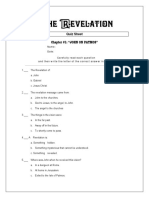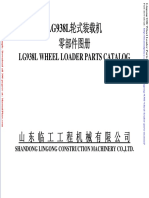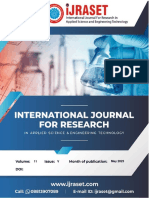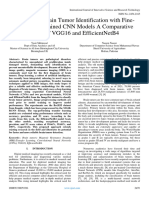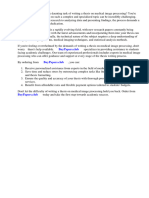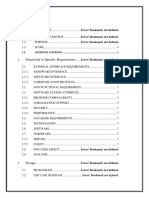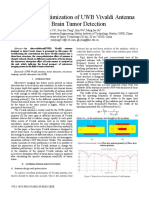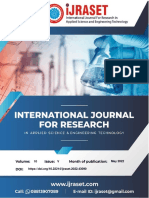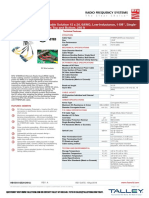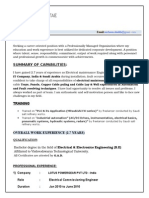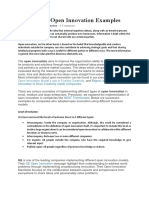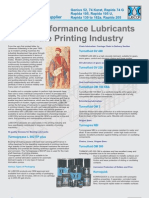Professional Documents
Culture Documents
Deep Learning Based Convolutional Neural Networks (DLCNN) On Classification Algorithm To Detect The Brain Turnor Diseases Using MRI and CT Scan Images
Original Title
Copyright
Available Formats
Share this document
Did you find this document useful?
Is this content inappropriate?
Report this DocumentCopyright:
Available Formats
Deep Learning Based Convolutional Neural Networks (DLCNN) On Classification Algorithm To Detect The Brain Turnor Diseases Using MRI and CT Scan Images
Copyright:
Available Formats
Volume 7, Issue 8, August – 2022 International Journal of Innovative Science and Research Technology
ISSN No:-2456-2165
Deep Learning based Convolutional Neural Networks
(DLCNN) on Classification Algorithm to Detect the
Brain Turnor Diseases using MRI
and CT Scan Images
T. Jagadeeswari1 , Dr. P. Srinivas2 Dr. Y.L. Malathi Latha3
Assistant Professor 1, Professor2 Associate Professor
Department of Computer Science & Engineering Department of Information Technology
Malla Reddy Engineering College (A) Mahatma Gandhi Institute of Technology(A)
Maisammaguda, Sec-bad Gandhipet, Hyd, Dist, R.R.
Dist.: Medichal,Telangana, India Telangana, India
Abstract:- The Brain Tumors is the one of the leading segmentation from claiming medicinal images will be a was
disease affects the humans, thus the early detection of troublesome task, Since they for the most part incorporate
brain tumors prevent millions of deaths. Thus, most of an expansive amount of data, Furthermore here and there a
the researches are focusing on detection of brain tumor couple artifacts due to patient’s restricted securing run
using machine learning based approaches. But, those through Furthermore fragile tissue boundaries, typically not
approaches are failed to provide the classification great defined. 2 At managing brain tumors, separate issues
accuracy. To overcome these drawbacks, in this work arise, which make their segmentation troublesome. There
Adative Neuron Fuzzy Inference System (ANFIS) based may be a limitless population about tumor sorts which bring
Deep Learning based Convolution Neural Networks a mixture of shapes also sizes. It might develop at whatever
(DLCNN) classification algorithm has been performing range also done divergent image intensities. Some about
with the help of effective use of Grey level Co-occurrence them misshape those encompassing structures or might
Matrix (GLCM) features. Initially, Probabilistic Kernel make identified with edema that transforms those intensities
Fuzzy C Means Segmentation (PKFCM) based multi from claiming images around those tumors. Additionally,
level segmentation operation has been performed to those presences from claiming a couple MRI procurement
detection of accurate tumor region. The simulations are conventions provides for divergent majority of the data on
conducted on various datasets, the results shows that the the brain. Each image generally highlights a specific region
proposed work shows the better performance compared of the tumor. The Robotized segmentation with former
to various conventional approaches with respect to both models alternately using the former information will be
quantitative and qualitative evaluation. challenged with executes. The flawed segmentation for
interior structures of the Brain is from claiming great energy
Keywords:- Brain Tumor , Detection, Disease, Fuzzy, should contemplate also for those medications from
Machine Learning , Deep Learning , Convolution and claiming tumors. It dives during diminishing those mortal
Segmentation. sins also upgrading the surgical or radio restorative. Over
saw economy for tumors. To brain oncology, it is also
I. INTRODUCTION alluring with bringing a reminiscent human brain model that
The brain tumor is a standout amongst the most widely could coordinate tumor data concentrated from MRI and CT
recognized as relatable point Brain illnesses. The World information, for example, such that localization, type, shape,
Health Organization (WHO) estimates that Analysis and utilitarian positioning, and additionally influence with
medicine would vital to more than 1crores population of respect to other brain structures. Despite different efforts
persons would endure from tumor for every year in the also guaranteeing brings about the therapeutic Imaging
globe. Developments in restorative imaging systems permit community, exact also proliferation segmentation and
using them inside few domains of medicine, for instance, abnormalities, Characterization need aid even now difficult
workstation helped pathologies diagnosis, surgical arranging assignments. Existing strategies clear out significant Space
and guidance, longitudinal dissection. Around every last one to expanded automation, materialness Furthermore
of restorative image modalities, Magnetic Resonance accuracy. In the requisition for image processing,
Imaging (MRI) also Computed Tomography (CT) need aid smoothening of the image will be, Crucial should aggravate
the mossy cup oak intermittently used imaging strategies the characteristic extraction also classification steps simpler.
clinched alongside neuroscience Furthermore neurosurgery. Hence impeccable sifting method is compulsory over
Segmentation of objects, primarily anatomic structures and biomedical image transforming. The Suitableness denoising
more Pathologies starting with MRI images may be a crucial calculation to MRI brain images may be vital to finish
task, since the outcomes every now and again turned the secondary execution. Those unwanted parcel in the MRI
foundation to different requisitions. Systems for performing images might Make evacuated by correct segmentation
segmentation shift comprehensively contingent upon those algorithm. Characteristic extraction is the following Stage
specific provisions and image modality. Additionally, the after preprocessing also 4 segmentation which may be took
IJISRT22AUG018 www.ijisrt.com 890
Volume 7, Issue 8, August – 2022 International Journal of Innovative Science and Research Technology
ISSN No:-2456-2165
after Eventually Tom's perusing characteristic The utilization of different DLCNN [5] for image order
Determination. The point when those required offers are breaks down. The absence of quicker union rate of the
chose it may be subjected of the Classification transform. traditional neural systems is additionally clarified. This lays
Those issues for picking those proper channels to Denoising, accentuation on the prerequisite of adjusted neural systems
segmentation algorithms, characteristic extraction with unrivaled meeting rate for image order applications. In
Furthermore prediction, calculation for those orders about authors have arranged four unique types of tumor utilizing
brain MRI images still remains as a real. To achieve this LDA method[6]. Be that as it may, the classification
extensive research goal, specific objectives are set. The precision revealed in the work is at the request of 80%
research objectives of this paper comprise of the following which is generally low. This additionally proposes the
components. different purposes behind misclassifications.SVM based
PKFCM is employed for detection of brain tumor characterization of different levels of MRI glioma images
effectively with exact Region of Interest (ROI) extraction was performed by authors in [7-8], which is guaranteed to
and feature extraction is done by utilizing GLCM be superior to anything principle based frameworks yet the
approach. precision revealed in the SVM based classification is low.
Finally, ANFIS based DLCNN is applied to classify This SVM based classification managed just glioma images
whether the image is normal or abnormal then form and subsequent absence of summing up capacity is another
abnormal the type of cancer is classified as benign or downside of this framework. In [8-9] authors need to utilize
malignant. those Kohonen neural networks to image classification. A
percentage adjustment of the accepted Kohonen neural
The remaining part of the paper is systematized as system is also actualized here, which demonstrated on a
follows. Section 2 describes the related works for brain chance to be a great deal better than those accepted neural
tumor detection and classification with their drawbacks, networks.
section 3 deals with proposed method detection and
classification of brain tumor with detailed operation. Section In [9-10] authors need to utilize a mixture
4 deals with experimental results of proposed method and methodology, for example, mix from claiming wavelets and
comparison with respect to the various state of art SVM to classifying those abnormal and the typical images.
approaches using quantitative evaluation and finally section This SVM technique uncovers the prevalence of the mixture
5 the conclusion and scope for future enhancements. SVM of the Kohonen neural networks as far as execution
measures. Yet the real detriment for this framework will be
II. LITERATURE SURVEY the little measure of the data set utilized to usage. The
classification precision outcomes might lessen when the
The classifier which is the way toward changing the span of the dataset will be expanded. An change about
quantitative input (i.e. Features) to subjective yield (i.e. customary SVM for example, any rate as square SVM (LS-
Diagnosis, prognosis, etc.) is considered the most essential SVM) for brain tumor distinguishment is suggested by
piece of an example order framework. The yield of the authors in [10-11]. Both bi-level classifications also
classifier can be either an unmistakable esteem, showing one multiclass order need aid performed with hint at those
of the predefined classes, or a genuine esteem vector, unrivaled way of the suggested system again the traditional
reflecting the probability that an example has a started from classifiers. This likewise specified a critical note that these
a particular class as depicted. To boost the execution of the contrasts between different calculations build when those
classifier, it is most essential to ideally tune all the former amounts about classes’ increment. Thus, this approach
stages (segmentation, feature extraction and choice). Setting suggested those needs to multiclass classification strategies
up a classifier requires three phases: the learning stage, the over bi-level classification systems. In turn adaptation for
execution assessments organize, and the testing stage. These LS-SVM is recommended and successfully actualized byy
stages, by and large, cover, as will be examined. Despite the authors in [9]. A far reaching similar examination will be
fact that it may appear to be intelligent that a bigger number performed the middle of those SVM, neural classifier and
of features would be more useful than fewer features, this the factual classifiers. 63 Effects proposed the preferences
isn't the case in genuine applications, because of the from claiming SVM as far as order exactness. Bi-level order
accompanying three primary reasons as depicted [2]. Right alone is performed, which will be insufficient for judging
off the bat the multifaceted nature and computational cost of those natures of the robotized framework in [10-11] authors
the classifier increments profoundly. Also, despite the fact utilize those altered PNN for tumor image order. Abnormal
that the quantity of misclassified information may diminish, images, for example, such that metastasis, glioma and
when more features are included for preparing the classifier, meningioma would separated utilizing the any rate as square
it has been demonstrated that the speculation blunder will characteristic conversion based PNN. A similar examination
inevitably increment [3]. Thirdly, on account of a may be additionally, performed for SVM. This methodology
predetermined number of accessible information and huge inferred that the convert based PNN may be better than the
number of accessible features, it is more probable that SVM as far as classification exactness. In [8-9] authors
features with little to no separation power will initiate bring illustrated another methodology by coordinating
clamor, debasing the speculation of the classifier to obscure wavelet entropy built spider meshing plots and PNN is
information [4]. Thusly, feature determination is an recommended to those orders of MRI brain images. Wavelet
imperative advance for drawing out the more instructive entropy based spider meshing plots to the characteristic
features and for ideal tuning the classifier's ability to extraction also PNN to the order. PNN gives a general
dependably characterize obscure data. answer for those example order issues and the corrected
IJISRT22AUG018 www.ijisrt.com 891
Volume 7, Issue 8, August – 2022 International Journal of Innovative Science and Research Technology
ISSN No:-2456-2165
order. In [8-10] authors bring introduced a canny order III. IMPLEMENTION OF PROPOSED METHOD
method should identify ordinary also, abnormal slices of the DLCNN CLASSIFICATION ALGORITHM
attractive reverberation human brain images (MRI and CT).
Over characteristic extraction stage, the practically Figure 1 shows the proposed method of brain cancer
proficient characteristics in statistical, and more Haar detection and classification process. Initially query image
wavelet offers would concentrate starting with each cut of applied from image acquisition unit, and then it is applied to
the brain MRI images. The order stage, at 70 first performs preprocessing stage. Here, by using different types of filters
order transform eventually Tom's perusing using FIS and to remove the artifacts and noises from source image and
more furthermore FFNN may be used to arrange those brain performs the image enhancement. Then PKFCM
tissues similarly as ordinary or abnormal. segmentation applied for brain tumor detection and effective
ROI extraction. Then by using the GLCM feature matrix to
achieve the features and create the database using features.
Then by applying the ANFIS based-DLCNN classification
methodology to detect the normal and abnormal stage of
cancer, at the same time type of classification also
recognized.
Image ANFIS-DLCNN
Segmentation Feature
Image
Acquisition Extractions Classification
preprocessing
Fig. 1: Proposed Method a DLCNN Classification Algorithm
Preprocessing: Images are generally infected by noise. brain tumor view which do not give any details regarding
Usually, noise is nothing but the unwanted by-product abnormalities. Hence, they are removed by keeping the
occurred during image capture. In general, noise occurs largest area in the Brain after thresholding and labeling the
due to various reasons likes imperfect instruments, connected components.
problems with the data acquisition process and interfering Segmentation: PKFCM segmentation algorithm
natural phenomena. Furthermore, noise is introduced by efficiently overcomes the geometric allied problem in
transmission errors and compression. The various types of FCM algorithm, but due to the absence of efficient spatial
noises are salt and pepper, impulse valued, spike, random, information, FCM is sensitive to noise. In the proposed
data drop out and independent noise. These clamors are PKFCM algorithm, spatial information is incorporated in
happened because of the sharp and unexpected changes of the form of kernel function which does not produce
picture sign and residue particles in the picture obtaining considerable effect on noise. Generally, the neighborhood
source or over warmed broken segments. In pre- pixels are highly correlated in spatial domain. Therefore, if
processing stage, the brain is filtered in order to improve the segmentation algorithm fails to incorporate the
the search for abnormalities without undue influence from relationship between the neighborhood pixels, the
the background of the brain and some filtering or cropping performance of the algorithm would be minimized due to
is accomplished in order to improve the quality of the of the effect of noise. To circumvent this shortcoming, in the
the image and to reduce noise. Brain MRI images contain proposed algorithm local neighborhood information is
some labels; those are equipment name, hospital name and integrated in the similarity measure of objective function.
The objective function of the proposed algorithm is defined as
𝐶
𝑛 2
m
𝐽𝑃𝐾𝐹𝐶𝑀 = ∑ (∑ Uik ||𝜑𝐿 (𝑥𝑘 ) − 𝜑𝐿 (𝑣𝑖 )|| ) (1)
𝑘=1
𝑖=1
The membership function 𝑈𝑖𝑘 is updated as
1
𝑈𝑖𝑘 = 𝑐
1⁄
(2)
𝐷 2 (𝑚−1)
∑ ( 𝑖𝑘 2 )
𝐷𝑗𝑘
𝑗=1
Where m is the fuzzy coefficient, and 𝐷𝑖𝑘 is the
similarity measure which is given as
IJISRT22AUG018 www.ijisrt.com 892
Volume 7, Issue 8, August – 2022 International Journal of Innovative Science and Research Technology
ISSN No:-2456-2165
𝐷𝑖𝑘 = ||𝜑𝐿 (𝑥𝑘 ) − 𝜑𝐿 (𝑣𝑖 )||2 (3) pixels on center pixel 𝑥𝑘 . The value of 𝛽 between 0 and 1
indicates the influence of neighboring pixels on center pixel.
Generally, c numbers of membership values are to be If 𝛽 value is 0, then the similarity measure tends to be that
computed for the pixel under consideration while of PKFCM algorithm without the above-specified spatial
segmentation an image into c clusters. Segmentation is information. The noise resistance capability of PKFCM
achieved by assigning the pixel to any cluster i for which it algorithm relies on the spatial function For any noisy center
possesses high membership value. From this, one can pixel 𝑥𝑘 having large gray level difference with its
deduce that the segmentation results rely on the similarity neighboring pixel 𝑥𝑎 , the spatial information 𝐻𝑖𝑘 computed
measure which is utilized to calculate the membership value. will be large, and thus the spatial function in above Equation
Therefore, in the proposed algorithm novel spatial becomes small for all values 𝛽 of other than zero. After the
neighborhood information is incorporated in its similarity first iteration, the noisy pixel 𝑥𝑘 will be attracted to the
measure to overcome the effect of noise. Incorporating cluster i to which its closest neighbor 𝑥𝑎 belongs. If the
spatial neighborhood information in the similarity measure value of𝐻𝑖𝑘 remains to be high till the last iteration, despite
results in being its dissimilarity, the center pixel 𝑥𝑘 will be forced to
cluster it is clear that after each iteration, the similarity
𝐷𝑖𝑘 = ||𝜑𝐿 (𝑥𝑘 ) − 𝜑𝐿 (𝑣𝑖 )||2 𝑔𝑖𝑘 (4)
measure of noisy pixels as well as other pixels in a window
In above equation the term 𝑔𝑖𝑘 indicates the spatial tend to a similar value, ignoring the noisy pixels. In this
information and is defined as case, the gray level value of noisy pixel is large when
compared to other pixels within the window, but the spatial
𝑔𝑖𝑘 = (1 − 𝛽𝐻𝑖𝑘 )(5) function𝑔𝑖𝑘 incorporated balances their similarity measure.
The spatial function thus eliminates the effect of noise in the
Here,𝐻𝑖𝑘 indicates spatial function for ROI region of segmentation process.
intrest(ROI), and 𝛽𝜖 [0,1] is neighborhood attraction
parameter that controls the significance of neighboring
Input: brain image, output: U cancer detected image
1: for t = 1: do
2: Randomly initialize membership matrix 𝑈𝑖𝑘 on input image I
3: Compute the spatial neighborhood information using Equation (5)
4: Compute the probability similarity measure using Equation (4)
5: Compute the updated membership value using Equation (2 )
6: Update objective function objective function 𝐽𝑃𝐾𝐹𝐶𝑀
7: end for
8: return U if the membership degrees of each pixel of the image to different clusters
Table 1: The DLCNN Classification Algorithm
Feature Extraction: For successful detection and segmented nodule. GLCM uses second order image
classification of brain cancer, the feature extraction stage statistics; it has an advantage that it considers the spatial
is very important. Since, the feature extraction techniques properties. But, it has limitation that it does not consider the
improve the performance of the system. Feature extraction primitive shapes. Hence, the performance of GLCM is very
is an important component that decides performance of effective in the classification of brain cancers compared to
classification. Feature extraction is also called as the other conventional features. Texture measures based on
description. Description deals with the process of FOS (or histogram based) are measured from the image
extracting attributes, which produce some quantitative pixel information and not considering the relationship
information of interest, in order to differentiate one class between neighboring pixels. Intensity levels of the entire
of objects from another. When the input data used for image are used in the texture analysis of histogram based
manipulation is complex, then it is converted into the approaches. Several FOS based features includes mean,
group of characteristics called feature vector. It is process variance, average energy, skewness and entropy.
of collecting image information such as color, shape, and Computation of histogram based gray level entails only
texture. Features comprise the appropriate information of single pixels. Histogram based method are easy to compute
an image and it is used in the image processing task the gray level images. Using histogram based features, the
(Examples: Searching, Retrieval, and Storing). characteristics of the lung nodule can be found.
In GLCM, the relevance of radius and angle are the Spatial distribution of gray level images estimates the
most crucial input parameters. Several First Order Statistics property of the image correlated to SOS which consider the
(FOS) texture features like mean, variance, energy skewness correlation between pixels. The SO image histograms are
and entropy and Second Order Statistics (SOS) comprises of defined by GLCM, which presents higher data concerning to
GLCM, contains features such as contrast, correlation, periodicity; spatial dependency and inter pixel bond of gray
cluster prominence, cluster shade, dissimilarity, level image. The GLCM is considered as the well known,
homogeneity, sum average, sum of squares, difference commonly used statistical technique for extracting texture
entropy and sum entropy are to be extricated from the features. It computes not only the single pixel but also the
IJISRT22AUG018 www.ijisrt.com 893
Volume 7, Issue 8, August – 2022 International Journal of Innovative Science and Research Technology
ISSN No:-2456-2165
neighborhood properties for extraction of features. Based on where 𝑣 is the function which takes one voxel from 26
joint probability distributions of pixel pair, this method can neighboring voxels according to the index α ,𝑃𝑥,𝑦,𝑧 is the
be employed. GLCM depicts how frequently the pixels are value of the voxel with xyz coordinates 𝛼is the ith entry of
positioned in the geometric location in relation with another the marginal probability matrix is achieved by the
pixel. summation of the row of 𝑃(𝑖, 𝑗).
GLCM of image𝑃(𝑖, 𝑗)can be expressed as GLCM can be calculated from texture images using
different values of θ and d and these probability values
𝑃(𝑖, 𝑗) = 𝑐𝑜𝑢𝑛𝑡 ((𝑃𝑥,𝑦,𝑧 , 𝑣)(𝑃𝑥,𝑦,𝑧 , 𝛼)) (6) = create the co-occurrence matrix 𝑃 (𝐼, 𝑗, 𝑑| , 𝜃 ) as shown in
𝑗, 𝛼€ {1,2,3, … … … … … … 26} figure 4. GLCM are considered for the orientations of 0°,
45°, 90°, and 135°; distance d =1,2,3 and 4 are calculated.
Fig. 2: Distances and Orientations to compute GLCM
ANFIS-DLCNN Classification: The essential structure of the fuzzy information database. It is contained three stages
a fuzzy inference framework is promoted in figure 3. The that progression the framework inputs to the fitting
framework changes over the crisp input to a linguistic framework outputs.
variable utilizing the membership functions put away in
Fig. 3: Structure Fuzzy Inference System
Database: A database which characterizes the dialect, rather than numerical qualities. At that point
membership functions of the fuzzy sets utilized as a part of membership functions are connected to the estimations
the fuzzy guidelines. and the level of truth in each introduce is resolved.
Fuzzification: The way toward changing crisp input Membership and rule generation: Membership
values into linguistic qualities is called fuzzification and it functions are utilized as a part of the fuzzification and
includes two procedures. To start with, the input qualities defuzzification ventures of a FIS, to outline non-fuzzy
are converted into linguistic ideas spoke to by fuzzy sets. input qualities to fuzzy linguistic terms and the other way
Linguistic variables are the input or output variables of the around. A membership function is utilized to evaluate a
framework whose qualities are from a characteristic linguistic term. The most well known sorts of membership
IJISRT22AUG018 www.ijisrt.com 894
Volume 7, Issue 8, August – 2022 International Journal of Innovative Science and Research Technology
ISSN No:-2456-2165
functions are triangular, trapezoidal along with Gaussian Defuzzification: On the off chance that a crisp estimation
shapes. For considering rule generation in a FIS, a rule of the framework is required, the last fuzzy output must be
base is assembled to control the output variable. A fuzzy defuzzified. This is the motivation behind the defuzzifier
rule is a simple IF-THEN rule by means of a condition as segment of a FLS. Defuzzification is performed by the
well as a conclusion. The estimations of the fuzzy rules membership function of the output variable. This can be
and the permutation of the consequences of the individual used by different techniques like gravity, bisector of area,
regulations are performed with fuzzy set operations. mean of maximum, smallest of maximum and largest of
maximum.
Fig. 4: Convolution Layers of DLCNN Classification
In the collected images 80% is used for training the normal and abnormal classification stage. These two levels
system and remaining 20% is used for testing the system. In are mapped as labels in output layer. Again the hidden layer
proposed work, deep learning is used for classification, also contains the abnormal cancer types separately; it is also
where the data rely on layers of the artificial neural holds the benign and malignant cancer weights in the second
networks whereas in current machine learning is used, stage of hidden layer. Similarly, these benign and malignant
requiring structured data as shown in figure 4. The output weights are also mapped as label into output layer. When the
layer depends on the input layer with multiple test image is applied, its GLCM features are applied for
interconnections of interchange nodes. Weight age value is testing purpose in the classification stage. Based on the
calculated for each node. If the intensity is high, then the maximum feature matching criteria utilizing Euclidean
weight age value will be around 0.9 or 0.8(high). If the distance manner it will function. If the feature match
intensity is less, then the weight age value is also less, occurred with hidden layer 1labels, then it is classified as
around 0.1 or 0.2. Weight age values of all the frames are normal brain tumor image. If the feature match occurred
summed up for the given image. The weight age values of with hidden layer 2 labels with maximum weight
an image containing the tumor and image not containing the distribution, then it is classified as benign effected cancer
tumor is calculated beforehand. The weight age that is found image. If the feature match occurred with hidden layer 2
for the given image is compared with weight age values labels with minimum weight distribution, then it is classified
tumor and no tumor images. Based on near similarities on as malignant affected cancer image.
weight age values, the image is classified. The advantage of
using DLCNN is it increases model complexity by adding IV. EXPERIMENTAL RESULTS
more layers. Therefore, it is more accurate compared to
SVM, which is a machine learning approach. Figure 4 Total 500 Brain tumor template images are adopted for
represents the architecture of artificial neural networks. this experiment analysis where 150 of malignant, 150 of
DLCNN basically consists of two stages for classification benign and 1350 of normal X-ray images with the
such as training and testing. The process of training will be consideration of patient mean age around 45.6year and
performed based on the layer based architecture. The input ranging from 18 to 81. The brain grazes assortment from
layer is used to perform the mapping operation on the input 2mm to 20mm in mass and several patients contain several
dataset; the features of this dataset are categorized into grazes whereas some other patients might have merely one.
weight distributions. Then the classification operation was Figure 4 shows the step by step output of the proposed
implemented in the two levels of hidden layer. The two methodology such as input MRI image, Pre-processed
levels of hidden layer hold individually normality and image, Multi Level segmentation, Brain Tumor Detected
abnormalities of the Brain cancer characteristic information. image and Tumor Classification output.
Based on the segmentation criteria, it is categorized as
IJISRT22AUG018 www.ijisrt.com 895
Volume 7, Issue 8, August – 2022 International Journal of Innovative Science and Research Technology
ISSN No:-2456-2165
(a)
(b)
Fig. 5: a. Input MRI image b. Brain Tumor Detected Images using MRI and CT Scan
Figure 5 represents the database of input images and
corresponding segmented images as tumor detected outputs. 𝑇𝑁
𝑆𝑝𝑒𝑐𝑖𝑓𝑖𝑐𝑖𝑡𝑦 =
For valuation of classification outcomes, we utilized three 𝑇𝑁 + 𝐹𝑃
qualitative metrics such as specificity, accuracy and
𝑇𝑃
sensitivity are very high. The accuracy can be defined as out 𝑆𝑒𝑛𝑠𝑖𝑡𝑖𝑣𝑖𝑡𝑦 =
of certain random test cases, how many outcomes give the 𝑇𝑃 + 𝐹𝑁
perfect classification output. The sensitivity is defined as where 𝑇𝑃 conveys the amount of test cases properly
individual classification accuracy, how much the method is recognized as malignant, 𝐹𝑃 conveys the amount of test
sensitive towards the malignant and benign cancers. And cases improperly recognized as malignant, 𝑇𝑁 conveys the
specificity is defined as the how much accurately the amount of test cases properly recognized as benign and 𝐹𝑁
location of tumor is recognized. is conveys the amount of test cases improperly recognized
as benign.
𝑇𝑃 + 𝑇𝑁
𝐴𝑐𝑐𝑢𝑟𝑎𝑐𝑦 =
𝑇𝑃 + 𝐹𝑃 + 𝑇𝑁 + 𝐹𝑁
Method Accuracy(in %) Specificity(in %) Sensitivity (in %)
SVM [1] 76.09 75.51 77.40
MK-SVM [2] 80.01 79.18 80.72
KNN [3] 80.42 80.18 81.81
CNN[4] 90.11 89.28 90.36
Proposed 95.91 95.81 96.34
Table 2: Performance of Quality Metrics using Existing and Proposed DLCNN-ANFISl-Model
In the training procedure, network limits were attuned neighbor (KNN) [3] classifiers from the literature for
by the preparation slaughter and after that the justification comparison with the proposed ANFIS-DLCNN classifier
dataset would be utilized to check the matching amount of model. Table 2 demonstrates that quality evaluation criteria
the attuned system. The matching curvatures of system of existing and proposed classifiers, where proposed ANFIS
depend on network testing slaughter and training loss -DLCNN classifier outperforms the conventional SVM,
slaughter. In order to additionally calculate the planned MK-SVM and KNN classifiers to distinguish the benign and
technique, we contrasted it with pair of NN-contained malignant from the brain tumor X-ray images and the
methods utilized in [2], [4]. For the categorization, we graphical representation presented in figure 6.
adopted SVM [1], multi-kernel SVM [2] and K-nearest
IJISRT22AUG018 www.ijisrt.com 896
Volume 7, Issue 8, August – 2022 International Journal of Innovative Science and Research Technology
ISSN No:-2456-2165
Fig. 6: Graphical Representation of Comparisons of SVM, MK-SVM, KNN and CNN
V. CONCLUSION [3.] Gurbină, Mircea, Mihaela Lascu, and Dan Lascu.
"Tumor Detection and Classification of MRI Brain
The proposed system is an optimization method for brain Image using Different Wavelet Transforms and
tumor detection at early stage itself. The proposed work Support Vector Machines." 2019 42nd International
starts by partitioning of images based on the direction of Conference on Telecommunications and Signal
captured MRI and CT is achieved through histogram Processing (TSP). IEEE, 2019.
equalization. Better segmentation achieved for feature [4.] Nazir, Muhammad, et al. "Brain tumor detection from
extraction by using GLCM. Each pixel is examined here to MRI images using multi-level wavelets." 2019
achieve higher accuracy. In this research, classification of International Conference on Computer and Information
brain tumor with benign and malignant tumors detected Sciences (ICCIS). IEEE, 2019.
from MRI images using a Deep Neural Network. Data [5.] Saba, Tanzila, et al. "Brain tumor detection using
augmentation helped to get better results with good fusion of hand crafted and deep learning
accuracy. Problems of over-segmentation have been features." Cognitive Systems Research 59 (2020): 221-
overcome by GLCM. Thus the location, size, and grade of 230.
the tumor is also detected which tells us whether the biopsy [6.] Amin, Javaria, et al. "Brain tumor detection using
is actually required or not, deaths occurring due to biopsy statistical and machine learning method." Computer
can be avoided. Our proposed architecture achieved high methods and programs in biomedicine 177 (2019): 69-
accuracy after providing the datasets for training. In future, 79.
exact shape also can be extracted along with size and [7.] Özyurt, Fatih, et al. "Brain tumor detection based on
location with high accuracy. Not only brain tumors but also Convolution Neural Network with neutrosophic expert
other diseases like lung cancer detection, brain cancer maximum fuzzy sure entropy." Measurement 147
detection etc can be detected using this system but by (2019): 106830.
providing the related datasets of that particular disease. In [8.] Thejaswini, P., Bhavya Bhat, and Kushal Prakash.
future more database images of primary and secondary "Detection and classification of tumour in brain
tumor along with various types can be further classified MRI." Int. J. Eng. Manufact.(IJEM) 9.1 (2019): 11-20.
reducing the computation and processing time of image [9.] Shakeel, P. Mohamed, et al. "Neural network based
classification using parallelization techniques. The future brain tumor detection using wireless infrared imaging
work also aims to predict the exact measurement of the sensor." IEEE Access 7 (2019): 5577-5588.
tumor so as to assist the physician to predict the severity of [10.] P.M.Kumar. "Satellite image denoising using local
the tumor easily. The soft computing techniques will be spayed and optimized center pixel
combined with VLSI and Embedded technology so that it weights." International Journal of Electrical and
can be directly incorporated in the system as chip set which Computer Engineering 4.5 (2014): 751.
makes the prediction process easier. The Accuracy, [11.] Megha, H. C. "The Research Assessment study on
Specificity and Sensitivity results are s 95.91%, 95.81% and Brain-Tumor Detection and Classification from MRI
96.34% respectively. Imaging test." International Journal of Scientific
REFERENCES Development and Research (IJSDR) www. ijsdr. Org.
IJSDR2005094,© May (2020): 2455-2631.
[1.] Khan, Muhammad A., et al. "Brain tumor detection
and classification: A framework of marker‐based
watershed algorithm and multilevel priority features
selection." Microscopy research and technique 82.6
(2019): 909-922.
[2.] Kasinathan, Gopi, et al. "Automated 3-D lung tumor
detection and classification by an active contour model
and CNN classifier." Expert Systems with
Applications 134 (2019): 112-119.
IJISRT22AUG018 www.ijisrt.com 897
You might also like
- Rev Quiz All PDFDocument46 pagesRev Quiz All PDFNota Belz82% (17)
- ICH Guidelines: Prsented By: Manish Shankarpure M.Pharm (Quality Assurances and Techniques)Document17 pagesICH Guidelines: Prsented By: Manish Shankarpure M.Pharm (Quality Assurances and Techniques)Manish shankarpureNo ratings yet
- Imageprocessing FinaldocDocument60 pagesImageprocessing FinaldocPattu SCNo ratings yet
- Image Super ResolutionDocument8 pagesImage Super ResolutionSam RockNo ratings yet
- Brain Tumor Detection Using Deep LearningDocument9 pagesBrain Tumor Detection Using Deep LearningIJRASETPublicationsNo ratings yet
- Hooded Scarf Project From Warm Knits, Cool GiftsDocument4 pagesHooded Scarf Project From Warm Knits, Cool GiftsCrafterNews33% (3)
- Liugong 938l Wheel Loader Parts ManualDocument20 pagesLiugong 938l Wheel Loader Parts Manualviolet100% (56)
- Saa6d170e-5 HPCR Egr Sen00190-04Document415 pagesSaa6d170e-5 HPCR Egr Sen00190-04Ahmad Mubarok100% (4)
- Factors Effecting PerformanceDocument47 pagesFactors Effecting Performancebembie83No ratings yet
- Monthly HSE report summaryDocument5 pagesMonthly HSE report summaryNiraNo ratings yet
- Cambridge English Pre A1 Starters Classroom Activities PDFDocument16 pagesCambridge English Pre A1 Starters Classroom Activities PDFFrank Guevara100% (2)
- Group 39Document6 pagesGroup 39Mrs. Megha V. Kadam DYPITNo ratings yet
- A Survey and Analysis of Intrusion Detection Models Based On Information Security and Object Technology-Cloud Intrusion DatasetDocument8 pagesA Survey and Analysis of Intrusion Detection Models Based On Information Security and Object Technology-Cloud Intrusion DatasetIAES IJAINo ratings yet
- Driver Drowsiness Detection System Using Deep LearningDocument12 pagesDriver Drowsiness Detection System Using Deep LearningIJRASETPublicationsNo ratings yet
- Dermatological Disorder Detection Using Machine LearningDocument4 pagesDermatological Disorder Detection Using Machine LearningInternational Journal of Innovative Science and Research TechnologyNo ratings yet
- Brain Tumour Detection Using The Deep LearningDocument8 pagesBrain Tumour Detection Using The Deep LearningIJRASETPublicationsNo ratings yet
- Advanced Driver Assistance System For Drivers Using Machine Learning and Artificial Intelligence TechniquesDocument10 pagesAdvanced Driver Assistance System For Drivers Using Machine Learning and Artificial Intelligence TechniquesIJRASETPublicationsNo ratings yet
- Optimizing Brain Tumor Identification With Fine - Tuned Pre-Trained CNN Models A Comparative Study of VGG16 and EfficientNetB4Document5 pagesOptimizing Brain Tumor Identification With Fine - Tuned Pre-Trained CNN Models A Comparative Study of VGG16 and EfficientNetB4International Journal of Innovative Science and Research TechnologyNo ratings yet
- Identification of Presence of Brain Tumors in MRI Images Using Contrast Enhancement TechniqueDocument8 pagesIdentification of Presence of Brain Tumors in MRI Images Using Contrast Enhancement Techniqueraymar2kNo ratings yet
- Mini Project Final ReviewDocument34 pagesMini Project Final ReviewArya Anandan100% (1)
- Brain Tumor Detection Using Segmentation of MriDocument4 pagesBrain Tumor Detection Using Segmentation of MriInternational Journal Of Emerging Technology and Computer Science100% (1)
- Recent Research Papers On Medical Image Processing PDFDocument5 pagesRecent Research Papers On Medical Image Processing PDFiiaxjkwgfNo ratings yet
- Final ReportDocument29 pagesFinal ReportManju ManikandanNo ratings yet
- ARDocument31 pagesARAmith Rahul PriyankNo ratings yet
- Augmented Reality: David JohnsonDocument26 pagesAugmented Reality: David JohnsonPranay Rawat100% (1)
- Chapter 2 AIDocument56 pagesChapter 2 AIOlana TeressaNo ratings yet
- CSE 299 Group ProposalDocument4 pagesCSE 299 Group ProposalSuraj Kumar DasNo ratings yet
- Identifying Diabetic Retinopathy with Probabilistic Neural NetworksDocument6 pagesIdentifying Diabetic Retinopathy with Probabilistic Neural NetworksThamimul AnsariNo ratings yet
- Brain Tumor Segmentation and Detection Using Deep LearningDocument5 pagesBrain Tumor Segmentation and Detection Using Deep Learningmohammad arshad siddiqueNo ratings yet
- Tumor Detection Using Zernike Moments and SegmentationDocument10 pagesTumor Detection Using Zernike Moments and SegmentationDemian PereiraNo ratings yet
- Chapter - 1Document16 pagesChapter - 1Waseem MaroofiNo ratings yet
- Photo Morphing Detection REPORTDocument63 pagesPhoto Morphing Detection REPORTPriyanka DargadNo ratings yet
- Brain Tumor Classification Using Machine Learning Mixed ApproachDocument8 pagesBrain Tumor Classification Using Machine Learning Mixed ApproachIJRASETPublicationsNo ratings yet
- East West Institute of Technology: An Improved Approach For Fire Detection Using Deep Learning ModelsDocument21 pagesEast West Institute of Technology: An Improved Approach For Fire Detection Using Deep Learning ModelsDeepuNo ratings yet
- Microsoft HoloLens: A Revolutionary Augmented Reality DeviceDocument20 pagesMicrosoft HoloLens: A Revolutionary Augmented Reality DeviceAakash VaishnavNo ratings yet
- 1.1 Introduction To SystemDocument19 pages1.1 Introduction To SystemRavi KumarNo ratings yet
- Traffic Sign Detection Using Yolo v5Document7 pagesTraffic Sign Detection Using Yolo v5IJRASETPublicationsNo ratings yet
- Car Make and Model Recognition Using ImaDocument8 pagesCar Make and Model Recognition Using ImaRAna AtIfNo ratings yet
- Seminar ReportDocument30 pagesSeminar ReportKhadeeja AshnaNo ratings yet
- Brain Tumor Detection Using IpDocument50 pagesBrain Tumor Detection Using Iplaxmana100% (1)
- ECE 5th Sem SyllabusDocument84 pagesECE 5th Sem SyllabusankurwidguitarNo ratings yet
- Detection of Covid-19 Using Deep LearningDocument6 pagesDetection of Covid-19 Using Deep LearningIJRASETPublicationsNo ratings yet
- COVID-19 Detection Using MLDocument5 pagesCOVID-19 Detection Using ML2BL17EC017 Archana KhotNo ratings yet
- A Collection of Related DiseasesDocument2 pagesA Collection of Related DiseasesLutfi AuliaNo ratings yet
- COVID-19 Image Classification Using Deep learning-ScienceDirectDocument34 pagesCOVID-19 Image Classification Using Deep learning-ScienceDirectGaspar PonceNo ratings yet
- Image Caption Generator Using Deep Learning: Guided by Dr. Ch. Bindu Madhuri, M Tech, PH.DDocument9 pagesImage Caption Generator Using Deep Learning: Guided by Dr. Ch. Bindu Madhuri, M Tech, PH.Dsuryavamsi kakaraNo ratings yet
- Brain Tumor Detection System Using Deep LearningDocument8 pagesBrain Tumor Detection System Using Deep LearningSruthi SomanNo ratings yet
- Literature Review On Single Image Super ResolutionDocument6 pagesLiterature Review On Single Image Super ResolutionEditor IJTSRDNo ratings yet
- EAgrobot - Plant Disease Detection and Precision Spraying Robot Using Image ProcessingDocument7 pagesEAgrobot - Plant Disease Detection and Precision Spraying Robot Using Image ProcessingIJRASETPublicationsNo ratings yet
- Brain Tumor Detection Using MRI ImagesDocument4 pagesBrain Tumor Detection Using MRI ImagesEditor IJTSRDNo ratings yet
- Traffic Signal Annunciator Alerts DriversDocument32 pagesTraffic Signal Annunciator Alerts DriversJayesh KolheNo ratings yet
- Real-time Semantic Segmentation with Fast AttentionDocument7 pagesReal-time Semantic Segmentation with Fast Attentiontest testNo ratings yet
- Review On MRI Brain Tumor Segmentation ApproachesDocument5 pagesReview On MRI Brain Tumor Segmentation ApproachesBONFRINGNo ratings yet
- Face Detection Techniques A Review PDFDocument22 pagesFace Detection Techniques A Review PDFRachmad HidayatNo ratings yet
- Project ReportDocument66 pagesProject ReportParasNo ratings yet
- Image Processing Seminar ReportDocument25 pagesImage Processing Seminar Reportsania2011No ratings yet
- Lung Cancer Detection Using Digital Image Processing On CT Scan ImagesDocument7 pagesLung Cancer Detection Using Digital Image Processing On CT Scan ImagesShaka TechnologiesNo ratings yet
- Final Screenless DisplayDocument4 pagesFinal Screenless DisplayMartinsNo ratings yet
- Output Devices:: Graphics Displays, Sound Displays & Haptic FeedbackDocument37 pagesOutput Devices:: Graphics Displays, Sound Displays & Haptic FeedbackSravan KumarNo ratings yet
- Augmented RealityDocument26 pagesAugmented RealityRONYROY222No ratings yet
- Brain Tumor Final Report LatexDocument29 pagesBrain Tumor Final Report LatexMax WatsonNo ratings yet
- Design and Optimization of UWB Vivaldi Antenna For Brain Tumor DetectionDocument3 pagesDesign and Optimization of UWB Vivaldi Antenna For Brain Tumor Detectionsamina taneNo ratings yet
- Brain Tumor Detection Algorithm PDFDocument5 pagesBrain Tumor Detection Algorithm PDFGanapathy Subramanian.S eee2017No ratings yet
- Pneumonia Detection Using VGG19 (Group No. 10)Document20 pagesPneumonia Detection Using VGG19 (Group No. 10)Amrit Kumar100% (1)
- Skin Cancer Detection Using Deep Learning TechniquesDocument11 pagesSkin Cancer Detection Using Deep Learning TechniquesIJRASETPublicationsNo ratings yet
- Internet of Things: by Abdulaziz OumerDocument29 pagesInternet of Things: by Abdulaziz OumerAbduro Yasin100% (1)
- Neural Network Based Brain Tumor Detection Using Wireless Infrared Imaging SensorDocument15 pagesNeural Network Based Brain Tumor Detection Using Wireless Infrared Imaging SensorAnitha.c.sNo ratings yet
- Parastomal Hernia: A Case Report, Repaired by Modified Laparascopic Sugarbaker TechniqueDocument2 pagesParastomal Hernia: A Case Report, Repaired by Modified Laparascopic Sugarbaker TechniqueInternational Journal of Innovative Science and Research TechnologyNo ratings yet
- Smart Health Care SystemDocument8 pagesSmart Health Care SystemInternational Journal of Innovative Science and Research TechnologyNo ratings yet
- Visual Water: An Integration of App and Web to Understand Chemical ElementsDocument5 pagesVisual Water: An Integration of App and Web to Understand Chemical ElementsInternational Journal of Innovative Science and Research TechnologyNo ratings yet
- Air Quality Index Prediction using Bi-LSTMDocument8 pagesAir Quality Index Prediction using Bi-LSTMInternational Journal of Innovative Science and Research TechnologyNo ratings yet
- Smart Cities: Boosting Economic Growth through Innovation and EfficiencyDocument19 pagesSmart Cities: Boosting Economic Growth through Innovation and EfficiencyInternational Journal of Innovative Science and Research TechnologyNo ratings yet
- Parkinson’s Detection Using Voice Features and Spiral DrawingsDocument5 pagesParkinson’s Detection Using Voice Features and Spiral DrawingsInternational Journal of Innovative Science and Research TechnologyNo ratings yet
- Predict the Heart Attack Possibilities Using Machine LearningDocument2 pagesPredict the Heart Attack Possibilities Using Machine LearningInternational Journal of Innovative Science and Research TechnologyNo ratings yet
- Impact of Silver Nanoparticles Infused in Blood in a Stenosed Artery under the Effect of Magnetic Field Imp. of Silver Nano. Inf. in Blood in a Sten. Art. Under the Eff. of Mag. FieldDocument6 pagesImpact of Silver Nanoparticles Infused in Blood in a Stenosed Artery under the Effect of Magnetic Field Imp. of Silver Nano. Inf. in Blood in a Sten. Art. Under the Eff. of Mag. FieldInternational Journal of Innovative Science and Research TechnologyNo ratings yet
- An Analysis on Mental Health Issues among IndividualsDocument6 pagesAn Analysis on Mental Health Issues among IndividualsInternational Journal of Innovative Science and Research TechnologyNo ratings yet
- Compact and Wearable Ventilator System for Enhanced Patient CareDocument4 pagesCompact and Wearable Ventilator System for Enhanced Patient CareInternational Journal of Innovative Science and Research TechnologyNo ratings yet
- Implications of Adnexal Invasions in Primary Extramammary Paget’s Disease: A Systematic ReviewDocument6 pagesImplications of Adnexal Invasions in Primary Extramammary Paget’s Disease: A Systematic ReviewInternational Journal of Innovative Science and Research TechnologyNo ratings yet
- Terracing as an Old-Style Scheme of Soil Water Preservation in Djingliya-Mandara Mountains- CameroonDocument14 pagesTerracing as an Old-Style Scheme of Soil Water Preservation in Djingliya-Mandara Mountains- CameroonInternational Journal of Innovative Science and Research TechnologyNo ratings yet
- Exploring the Molecular Docking Interactions between the Polyherbal Formulation Ibadhychooranam and Human Aldose Reductase Enzyme as a Novel Approach for Investigating its Potential Efficacy in Management of CataractDocument7 pagesExploring the Molecular Docking Interactions between the Polyherbal Formulation Ibadhychooranam and Human Aldose Reductase Enzyme as a Novel Approach for Investigating its Potential Efficacy in Management of CataractInternational Journal of Innovative Science and Research TechnologyNo ratings yet
- Insights into Nipah Virus: A Review of Epidemiology, Pathogenesis, and Therapeutic AdvancesDocument8 pagesInsights into Nipah Virus: A Review of Epidemiology, Pathogenesis, and Therapeutic AdvancesInternational Journal of Innovative Science and Research TechnologyNo ratings yet
- Harnessing Open Innovation for Translating Global Languages into Indian LanuagesDocument7 pagesHarnessing Open Innovation for Translating Global Languages into Indian LanuagesInternational Journal of Innovative Science and Research TechnologyNo ratings yet
- The Relationship between Teacher Reflective Practice and Students Engagement in the Public Elementary SchoolDocument31 pagesThe Relationship between Teacher Reflective Practice and Students Engagement in the Public Elementary SchoolInternational Journal of Innovative Science and Research TechnologyNo ratings yet
- Investigating Factors Influencing Employee Absenteeism: A Case Study of Secondary Schools in MuscatDocument16 pagesInvestigating Factors Influencing Employee Absenteeism: A Case Study of Secondary Schools in MuscatInternational Journal of Innovative Science and Research TechnologyNo ratings yet
- Dense Wavelength Division Multiplexing (DWDM) in IT Networks: A Leap Beyond Synchronous Digital Hierarchy (SDH)Document2 pagesDense Wavelength Division Multiplexing (DWDM) in IT Networks: A Leap Beyond Synchronous Digital Hierarchy (SDH)International Journal of Innovative Science and Research TechnologyNo ratings yet
- Diabetic Retinopathy Stage Detection Using CNN and Inception V3Document9 pagesDiabetic Retinopathy Stage Detection Using CNN and Inception V3International Journal of Innovative Science and Research TechnologyNo ratings yet
- Advancing Healthcare Predictions: Harnessing Machine Learning for Accurate Health Index PrognosisDocument8 pagesAdvancing Healthcare Predictions: Harnessing Machine Learning for Accurate Health Index PrognosisInternational Journal of Innovative Science and Research TechnologyNo ratings yet
- Auto Encoder Driven Hybrid Pipelines for Image Deblurring using NAFNETDocument6 pagesAuto Encoder Driven Hybrid Pipelines for Image Deblurring using NAFNETInternational Journal of Innovative Science and Research TechnologyNo ratings yet
- Formulation and Evaluation of Poly Herbal Body ScrubDocument6 pagesFormulation and Evaluation of Poly Herbal Body ScrubInternational Journal of Innovative Science and Research TechnologyNo ratings yet
- The Utilization of Date Palm (Phoenix dactylifera) Leaf Fiber as a Main Component in Making an Improvised Water FilterDocument11 pagesThe Utilization of Date Palm (Phoenix dactylifera) Leaf Fiber as a Main Component in Making an Improvised Water FilterInternational Journal of Innovative Science and Research TechnologyNo ratings yet
- The Making of Object Recognition Eyeglasses for the Visually Impaired using Image AIDocument6 pagesThe Making of Object Recognition Eyeglasses for the Visually Impaired using Image AIInternational Journal of Innovative Science and Research TechnologyNo ratings yet
- The Impact of Digital Marketing Dimensions on Customer SatisfactionDocument6 pagesThe Impact of Digital Marketing Dimensions on Customer SatisfactionInternational Journal of Innovative Science and Research TechnologyNo ratings yet
- Electro-Optics Properties of Intact Cocoa Beans based on Near Infrared TechnologyDocument7 pagesElectro-Optics Properties of Intact Cocoa Beans based on Near Infrared TechnologyInternational Journal of Innovative Science and Research TechnologyNo ratings yet
- A Survey of the Plastic Waste used in Paving BlocksDocument4 pagesA Survey of the Plastic Waste used in Paving BlocksInternational Journal of Innovative Science and Research TechnologyNo ratings yet
- Cyberbullying: Legal and Ethical Implications, Challenges and Opportunities for Policy DevelopmentDocument7 pagesCyberbullying: Legal and Ethical Implications, Challenges and Opportunities for Policy DevelopmentInternational Journal of Innovative Science and Research TechnologyNo ratings yet
- Comparatively Design and Analyze Elevated Rectangular Water Reservoir with and without Bracing for Different Stagging HeightDocument4 pagesComparatively Design and Analyze Elevated Rectangular Water Reservoir with and without Bracing for Different Stagging HeightInternational Journal of Innovative Science and Research TechnologyNo ratings yet
- Design, Development and Evaluation of Methi-Shikakai Herbal ShampooDocument8 pagesDesign, Development and Evaluation of Methi-Shikakai Herbal ShampooInternational Journal of Innovative Science and Research Technology100% (3)
- NCERT Solutions For Class 8 Science Chapter 6Document4 pagesNCERT Solutions For Class 8 Science Chapter 6D Rong saNo ratings yet
- Heyer Et Al - 1994 - 5 e 6 - Measuring and Monitoring Biological Diversity. Standard Methods For Amphibians - Preface and Cap1Document8 pagesHeyer Et Al - 1994 - 5 e 6 - Measuring and Monitoring Biological Diversity. Standard Methods For Amphibians - Preface and Cap1Vítor Carvalho RochaNo ratings yet
- HYBRIFLEX® RRH Hybrid Cable Solution 12 X 24, 6AWG, Low-Inductance, Single-Mode Fiber, DLC Connectors Top and Bottom, 240 FTDocument3 pagesHYBRIFLEX® RRH Hybrid Cable Solution 12 X 24, 6AWG, Low-Inductance, Single-Mode Fiber, DLC Connectors Top and Bottom, 240 FTNoame Pauline SimbajonNo ratings yet
- Upper Gastro Intestinal BleedingDocument13 pagesUpper Gastro Intestinal BleedingmuniningmicanNo ratings yet
- A 1000 Calorie Diet Plan For Weight Loss - DMooseDocument15 pagesA 1000 Calorie Diet Plan For Weight Loss - DMoosekwasnyciakristinaNo ratings yet
- Hydroelectric and Pumped Storage, Tidal, WaveDocument62 pagesHydroelectric and Pumped Storage, Tidal, WavePrince AbrahamNo ratings yet
- What Are The Different Types of PollutionDocument9 pagesWhat Are The Different Types of PollutionPatricia DurandNo ratings yet
- Eating Healthily: People's Mixed ViewsDocument2 pagesEating Healthily: People's Mixed ViewsTbb GajahMada MagetanNo ratings yet
- Applications of Sine and Cosine Functions PDFDocument1 pageApplications of Sine and Cosine Functions PDFShane RajapakshaNo ratings yet
- Indian MaDocument1 pageIndian MaAnass LyamaniNo ratings yet
- Fiitjee: All India Internal Test SeriesDocument16 pagesFiitjee: All India Internal Test SeriesAditya KashyapNo ratings yet
- Bangla FoodsDocument6 pagesBangla FoodsSubadrika DarmadewiNo ratings yet
- Water Cycle Cer 002Document2 pagesWater Cycle Cer 002api-434008934No ratings yet
- Datasheet GenDocument2 pagesDatasheet GenEdgar Bonilla MuñozNo ratings yet
- Paper1202169 2180 PDFDocument12 pagesPaper1202169 2180 PDFManish AnandNo ratings yet
- Lecture 10Document19 pagesLecture 10Sara AlwehrNo ratings yet
- Stress 1Document28 pagesStress 1DrAma StabLeNo ratings yet
- CV Electrical Engineer 2.7 Yrs ExpDocument4 pagesCV Electrical Engineer 2.7 Yrs ExpShams Tabrez0% (1)
- 5 Successful Open Innovation ExamplesDocument44 pages5 Successful Open Innovation ExamplesSambhav MehtaNo ratings yet
- SR-21 SniperDocument6 pagesSR-21 SniperBaba HeadquaterNo ratings yet
- Printing MachineDocument2 pagesPrinting MachinephamdoanketNo ratings yet
- Fault Codes: Brake (DSC/DXC (Dynamic Stability Control) - Bosch 8.0 - Tyre Pressure Monitoring)Document5 pagesFault Codes: Brake (DSC/DXC (Dynamic Stability Control) - Bosch 8.0 - Tyre Pressure Monitoring)zacarias NiquiceNo ratings yet
